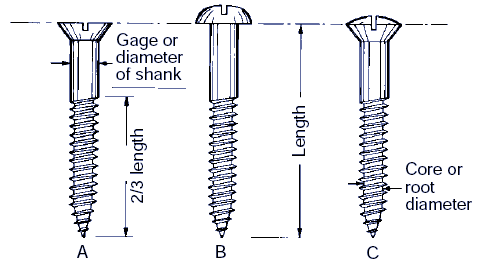Related Resources: calculators
Wood Screw Pullout Withdraw Resistance Force Formulae and Calculator.
Strength Mechanics of Materials
Beam Deflections, Stress Analysis and Engineering
Civil Engineering and Design
Wood Screw Pullout Withdraw Resistance Force Formulae and Calculator

Wood Screws Types
Preview Wood Screw Pullout Withdraw Resistance Force Calculator
Wood Screws Types:
The common types of wood screws have flat, oval, or round heads. The flathead screw is most commonly used if a flush surface is desired. Ovalhead and roundhead screws are used for appearance, and roundhead screws are used when countersinking is objectionable. The principal parts of a screw are the head, shank, thread, and core (see image above). The root diameter for most sizes of screws averages about two-thirds the shank diameter. Wood screws are usually made of steel, brass, other metals, or alloys, and may have specific finishes such as nickel, blued, chromium, or cadmium. They are classified according to material, type, finish, shape of head, and diameter or gauge of the shank.
Experimental Pullout Loads:
The resistance of wood screw shanks to withdrawal from the side grain of seasoned wood varies directly with the square of the specific gravity of the wood. Within limits, the withdrawal load varies directly with the depth of penetration of the threaded portion and the diameter of the screw, provided the screw does not fail in tension. The screw will fail in tension when its strength is exceeded by the withdrawal strength from the wood. The limiting length to cause a tension failure decreases as the density of the wood increases since the withdrawal strength of the wood increases with density. The longer lengths of standard screws are therefore superfluous in dense hardwoods.
The withdrawal resistance of type A tapping screws, commonly called sheet metal screws, is in general about 10% greater than that for wood screws of comparable diameter and length of threaded portion. The ratio between the withdrawal resistance of tapping screws and wood screws varies from 1.16 in denser woods, such as oak, to 1.05 in lighter woods, such as redwood.
Ultimate test values for withdrawal loads of wood screws inserted into the side grain of seasoned wood may be expressed as:
p = 108.25 G2 D L (Metric screws)
p = 15,700 G2 D L ( inch-lbs)
Where:
p = Maximum withdrawal load (N, lb),
G = Specific gravity based on ovendry weight and volume at 12% moisture content,
D = shank diameter of the screw (mm, in.),
L = Length of penetration of the threaded part of the screw (mm, in.).
Notes:
- (The NDS and LRFD use ovendry weight and volume as a basis.) These values are based on reaching ultimate load in 5 to 10-min.
- These equations are applicable when screw lead holes have a diameter of about 70% of the root diameter of the threads in softwoods, and about 90% in hardwoods.
- The equation values are applicable to the screw sizes listed in Table A. (Shank diameters are related to screw gauges.)
- For lengths and gauges outside these limits, the actual values are likely to be less than the equation values.
- The withdrawal loads of screws inserted in the end grain of wood are somewhat erratic, but when splitting is avoided, they should average 75% of the load sustained by screws inserted in the side grain.
- Lubricating the surface of a screw with soap or similar lubricant is recommended to facilitate insertion, especially in dense woods, and it will have little effect on ultimate withdrawal resistance.
|
Screw Length
(mm, (in)) |
Gauge Limits
|
|
12.7 (1/2)
|
1 to 6
|
|
19.0 (3/4)
|
2 to 11
|
|
25.4 (1)
|
3 to 12
|
|
38.1 (1-1/2)
|
5 to 14
|
|
50.8 (2)
|
7 to 16
|
|
63.5 (2-1/2)
|
9 to 18
|
|
76.2 (3)
|
12 to 20
|
Related web pages:
- Wood Engineering Properties (Specific Gravity) for Hardwoods
- Wood Engineering Properties (Specific Gravity) #2
- Wood Engineering Properties (Specific Gravity) #3 Engineering Properties
- Density of Wood Equation and Calculator
- Wood Screw Sizes and Design Data
- Pilot Hole Drill Sizes for Wood Screws
- Pilot Holes for American Wood Screws
- American Wood Screws
Special Note to Non-Engineers
We think it's great that you're here on Engineers Edge, but know that this technical data is written for engineers and designers. Engineers Edge is an engineering and design consulting, training and publishing firm and does not provide extended support to our general website visitors. There is a feedback form available and any and all professional comments are welcome.
References:
- AF&PA. 1997. National design specification for wood construction. Washington, DC: American Forest & Paper Association.
- ASCE. 1995. Standard for load and resistance factor design (LRFD) for engineered wood construction. Washington, DC:
- American Society of Civil Engineers. ASCE. 1996. Mechanical connections in wood structures. Washington, DC: American Society of Civil Engineers.